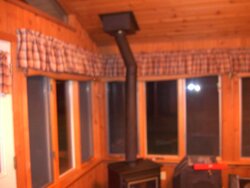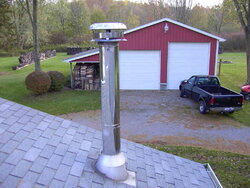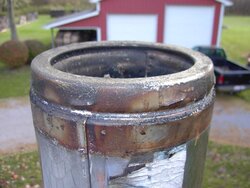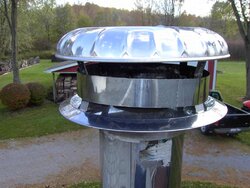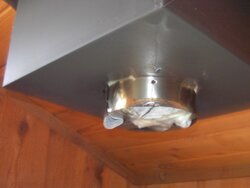I reused some snap lock class A pipe (6" black single wall) when I installed my Englander nc13 to replace an old stove.This is from the stove up to the ceiling box. The snap lock leaked too much around the joints. Will Duravent or Selkirk pipe give me better draft (fit tighter) or should I seal the snap lock with something?
Class A stove pipe question.
- Thread starter bsa0021
- Start date
-
Active since 1995, Hearth.com is THE place on the internet for free information and advice about wood stoves, pellet stoves and other energy saving equipment.
We strive to provide opinions, articles, discussions and history related to Hearth Products and in a more general sense, energy issues.
We promote the EFFICIENT, RESPONSIBLE, CLEAN and SAFE use of all fuels, whether renewable or fossil.
You are using an out of date browser. It may not display this or other websites correctly.
You should upgrade or use an alternative browser.
You should upgrade or use an alternative browser.
- Status
- Not open for further replies.
Snap-lock, single wall is not class A pipe. Class A pipe is hopefully what you have on top of your cathedral ceiling support box. What brand pipe is the support box?
Leakage should not occur even with single wall unless there is a problem like too short a chimney, or a clogged pipe or cap. How much class A pipe is above the ceiling support box?
Leakage should not occur even with single wall unless there is a problem like too short a chimney, or a clogged pipe or cap. How much class A pipe is above the ceiling support box?
I have double wall stainless steel pipe coming off the roof about 5' up. The previous stove was installed by the place I bought the stove from. They used the snap lock pipe inside up to the ceiling box. When I put in the Englander, I had to change the pipe inside because the Englander was shorter and the flue exited out the middle of the stove. I had poor draft after I made the changes to the pipe (did a match test at the seams). Are you telling me that the original installer should not have used snap lock at all? I don't know what brand of double wall pipe they used above the support box.
How much class A is above the support box? That might be part of the problem, especially in milder weather.
madison
Minister of Fire
I believe it should it be class A to transition the support box.
Class A does come in black, -- or the galvanized class A can be painted with hi temp paint.
Class A does come in black, -- or the galvanized class A can be painted with hi temp paint.
class A is not used to connect the stove. Single or double wall connector pipe is used there. Give the smoke leakage concerns I would consider double-wall connector. If this is the choice it should be of the same brand as the support box and class A piping above the support box.
madison
Minister of Fire
Alright, a little more history behind my set up. Before the Englander, I had a down draft stove that DID NOT have any draft problems. The only changes that I made was to the black single wall pipe inside the room from the stove to the ceiling support box. When I made these changes I had trouble installing the pipe without a slip connector and I may have damaged the connections. My old stove had a removable collar to make pipe removal easier. I believe that with the current piping I am getting leaks at the two adjustable 45s and at the joints where the remainer of the pipe join together.
madison said:Is it not required that the class A transition below than go thru the support box AND ceiling?
What is required is that the support box/class A be installed precisely as delineated in the installation instructions. Every manuf does pretty much the same thing, but each has specific components to make their "system" operate and not aggravate your insurance company. That stove pipe connector to class A varies slightly by manuf.
To the original posters question about the snap lock, I have to say that my preference is to use the double wall. Stainless, close clearance, 10yr warranty and for my money, better operation. Cost is certainly the issue, but with their telescoping sections you can trim it out properly and have it look like it supposed to be there.
To the original posters question about the snap lock, I have to say that my preference is to use the double wall. Stainless, close clearance, 10yr warranty and for my money, better operation. Cost is certainly the issue, but with their telescoping sections you can trim it out properly and have it look like it supposed to be there.[/quote]
But single wall pipe will help heat the room where double wall will not.
But single wall pipe will help heat the room where double wall will not.
madison said:Is it not required that the class A transition below than go thru the support box AND ceiling?
Depends on the manufacturer madison. Some support boxes cradle and terminate the class A at the support box. And some have the class A going through it.
But single wall pipe will help heat the room where double wall will not.
What brand is the class A and support box? Simpson?
FWIW, double-wall does radiate quite a bit of heat, just not as much as single-wall. Often this is a good thing, especially with an efficient stove the has cooler flue pipe temps.
It would take a close eye or a label on the class A to indicate this. It looks a bit like Simpson, but I can't be sure. Was there a slender stainless ring coupling the old setup connector pipe to the support box?
So, about 5' above in class A and about 5' blow with an offset, correct? That seems like a very short pipe. I can start understanding why it is leaking out of the seams. To remedy I would find out the mfg. of the class A system and then install their matching double-wall to connect the stove.
So, about 5' above in class A and about 5' blow with an offset, correct? That seems like a very short pipe. I can start understanding why it is leaking out of the seams. To remedy I would find out the mfg. of the class A system and then install their matching double-wall to connect the stove.
bsa0021 said:To the original posters question about the snap lock, I have to say that my preference is to use the double wall. Stainless, close clearance, 10yr warranty and for my money, better operation. Cost is certainly the issue, but with their telescoping sections you can trim it out properly and have it look like it supposed to be there.
But single wall pipe will help heat the room where double wall will not.[/quote]
You are certainly correct. Single wall does give up more heat. In the past couple decades most of my venting experience has been in the oil and gas furnace/boiler industry. With code changes and increases in efficiency and recognition of what is really happening in the flue pertaining to dew point issues the double wall connector is king from a performance standpoint. According to a report done by Brookhaven Nat'l Labs the engineer who ran the project said that the most important factor in lined, unlined, indoor outdoor chimney was the lay-out and construction of the vent connector. Double wall dramatically improved performance in oil and gas performance.
I realize that we are talking another fuel here, but i want my "Stove" to heat the space. Whatever temperature is left when exiting the appliance I want to drive the draft. That said, I'm a believer in double wall, and I do think it looks better when installed.
This is correct. You want the flue gases to remain hot enough to encourage good draft and minimize creosote condensation. Most mfgs do not recommend a run of single wall greater than 8 ft for this reason.
Try posting a good picture of the pipe and cap, maybe we can id it that way? Otherwise, a certified and experienced sweep may be the best on-location determinant.
O
oldspark
Guest
oldspark said:IMHO-chimney is too short, single wall, double wall, or infinity wall the things too short.
When I purchased the original stove 6 years ago, I planned on installing it myself but when I called my insurance company to tell them I was getting a stove, my agent would only approve if it was "professionally" installed. I did not have good internet access back then so I had to trust the installer. This is just another reason I do everthing I can myself. You never know what kind of work someone is going to do. I know good work can be found but I seem to be a magnet for idoits.
I know good work can be found but I seem to be a magnet for idoits.
I know the feeling! Nice wood stacks there bsa.
The pictures help. From the cap style it looks like Security Secure-Temp chimney to me. More pipe should help but be sure to add a roof brace at the 5 ft level.
Yes, you should use the same brand pipe for indoors. I think adding 2-3 feet of pipe will suffice. If you want to try a test, pull the cap and take a 3 ft length of cheap snap lock and put it in the class A (crimp down) for a temporary extension. Do this on a calm day with little wind. Then light up the stove and see how it performs.
- Status
- Not open for further replies.
Similar threads
- Replies
- 2
- Views
- 374
- Replies
- 5
- Views
- 938
- Replies
- 0
- Views
- 362
- Replies
- 4
- Views
- 762


